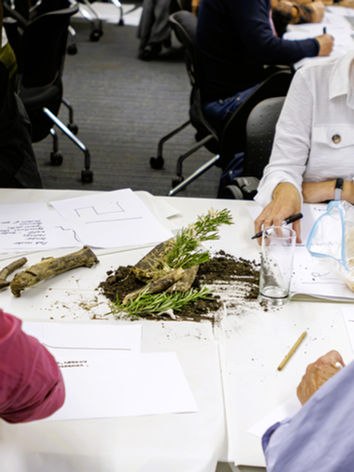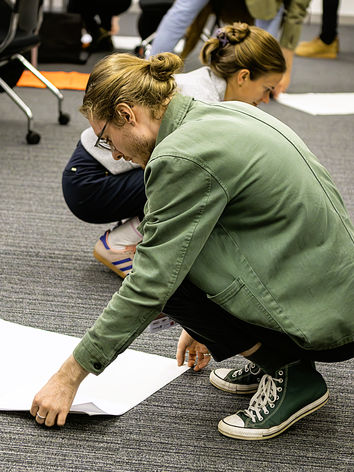Suffolk Design
Festival 2025
That’s a Wrap, Buh!

We opened with “alright buh,” and spent the day delving into the real issues behind place quality. It was a festival full of insight, energy, and honest conversations.
One attendee summed it up perfectly:
“It was a great day – so much so, my architect announced she was going home to ‘rip up her site plans’ and start again…! So you certainly inspired her!”
That’s what the Suffolk Design Festival was all about: inspiring better thinking, better collaboration, and ultimately, better places.
From national voices to local reality, this was a day for reflection, ambition, and collective momentum.
Presentations
Workshops
Voices from the Stage
Anna Rose (Planning Advisory Service & Public Practice)
"Design quality doesn’t happen by accident, it needs tools, trust, and talent."
-
Planning reform must go hand-in-hand with design literacy.
-
Fees and resources need to match expectations for quality.
-
Fixing the skills gap means investing in leadership and culture.
-
Scale is about more than numbers, it’s about vision, phasing, and stewardship.
Ben Woolnough (East Suffolk Council)
"Relatable design is what people live with, not just what we draw on a screen."
-
Highlighted the challenge of pushing for quality without internal capacity
-
Stressed the value of consistent tools and clear expectations.
-
Called for respectful dialogue between planners and applicants.
Hana Loftus (HAT Projects)
"Every project faces risk, contradiction, and compromise, design is how we respond."
-
Shared the private sector reality of juggling viability, risk, and regulation.
-
Planners should trust designers and avoid over-tweaking.
-
Real collaboration is the key to raising quality across the board
Professor Matthew Carmona (UCL)
"Poor design isn’t inevitable, it’s systemic. But so is good design, when we choose it."
-
Introduced ten proven routes to success in disadvantaged areas.
-
Emphasised early collaboration, strong leadership, and community voice.
-
Called for challenges to poor standards early in the process.
Useful Links
Workshop Round-Up
The afternoon saw five workshops tackle the topics shaping the future of placemaking in Suffolk:
Sustainable Drainage
Kevin Barton challenged attendees to rethink how water can shape and define public spaces.
Urban Green Infrastructure
Howard Gray unpacked the tree-first mindset , from planning to planting.
Healthy Streets
Create Streets asked: how do we design for walkability, safety, and social life?
Local Identity and Heritage
Paulette McAllister explored how we reconnect with our 9 senses in linking this to place.
Sustainability and Climate Walking Tour
Julie Futcher and Alison Pooley took delegates on a live critique of the built environment around Ipswich.
Photo credit: Joshua Bishop – joshuabishopphotography.com
Survey Says...
1. Who is Seen as Responsible for Good Design?
Local authorities and designers/consultants were consistently seen as having the greatest responsibility across all sectors.
-
Local authority respondents placed slightly more emphasis on their own role and that of developers.
-
Private practice leaned more heavily toward designers/consultants and clients/landowners.
-
Developers acknowledged the role of designers but rarely pointed to national government, indicating a preference for localised responsibility.
2. What Are the Biggest Barriers?
Market pressures/viability was the top concern across the board, especially for local authorities and private practices.
-
Local authorities also highlighted lack of time/resources and skills as major issues, reflecting known capacity constraints.
-
Private practice focused more on poor client leadership and policy weakness, possibly indicating frustrations with brief quality and clarity.
-
Developers showed a broader spread of concerns but echoed viability pressures.
3. What Should Suffolk Prioritise?
Local authorities prioritised ambitious design codes and climate resilience.
-
Private practice opted for innovative housing/street design and skills sharing, suggesting a desire for bolder, design-led solutions.
-
Other sectors, including academia and housing associations, leaned more towards policy leadership and better community engagement.
4. Resources Used
Local Design SPD/Codes and the National Design Guide were widely used, especially among local authority staff.
-
Private practice had higher engagement with local design review panels.
-
Developers used fewer formal resources overall, with some indicating none of the above, a potential area for better signposting and resource alignment.
5. Influence Over Design Quality
Local authority officers mostly rated their influence at 3 or 4, suggesting moderate perceived control.
-
Private sector respondents had more polarised responses, from very low (1–2) to high (5), reflecting the variability of their roles and client relationships.
-
Developers and housing associations generally felt less influence, which may explain their focus on viability as a barrier.
Insights & Opportunities
-
There’s broad agreement on shared responsibility for good design, but views differ slightly depending on the constraints of each sector.
-
Capacity issues in councils are seen internally and externally as a serious barrier, support for skill-sharing or joint working may land well.
-
Ambition exists, across all sectors, to do more with codes, leadership, and innovation. The appetite is there; Suffolk just needs to channel it.
-
The influence gap between those designing and those deciding is real. Creating better collaboration mechanisms between public and private could be key.
What We Learned
-
There’s more common ground between public and private than we often admit.
-
Suffolk is full of people ready to lead, collaborate and challenge.
-
Codes, climate, and co-design aren’t trends, they’re tools.
-
Design quality happens when we bring the right people together early.
What Next?
This was never meant to be a one-off.
-
Would you like another festival next year?
-
Would you be up for shaping it? Hosting a session? Running a workshop?
We're not asking for perfection, just energy, ideas and an open mind.
Sign up to the Suffolk Design website
Get tools, events, resources and support across the county
www.suffolkdesign.uk
Tell us what you thought
Take 2 mins to complete our feedback form.
























